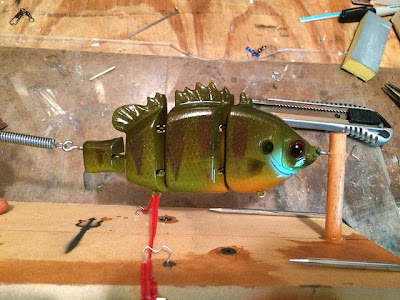In nine days I leave for a guy's getaway to Rockport, TX. In the coastal bend of the Texas Gulf Coast, Rockport and the surrounding ports and bays have great big fish potential.
For several years we have gone to Galveston but this year, I wanted to branch out. I wanted to try some new water, some clearer water, maybe on a bay and with some green lights behind the house. We found one suited for our needs and booked it. That has been almost four months ago now and we are just nine days away.
With the many distractions of freshwater fishing in tournaments, doing kayak demos, going to big get togethers and family time, I haven't until this week been able to really focus on what is about to go down. I have been doing some recon here and there and have talked to a few guides in the area. Going on some of their recommendations, I've purchased a few lures. Going off on my own, I have purchased a few others.
Of the new baits, there are three that I am most excited about.
The first one is a custom swimbait from Neptune Customs. These are typically made for big freshwater bass but I had Jesse outfit it with saltwater parts; I plan to swim it through the edges of the lights at night. Maybe it will work for trout, maybe it won't but I am going to try it. I'm not shy when it comes to trying new things and even out of the box things. My Neptune is in a floater gill. This is it on the rack as it is curing the top coat. It'll be here Friday most likely.
The second bait is from Henry Stokes at Skinny Water Arsenal. It is an imitation shrimp that is weedless and made to swim just like a shrimp. It is a soft bait so it swims easily and the fish will hold onto it longer. I got some great advice on these from Dean Thomas at Slowride Guide Service. These are also not commercially available en mass so you have to call Dean or visit the one shop that has them. I can't wait to drag this through a drain on some tailers.
The third bait caught me from a rack at Cabelas. I had never seen a more realistic looking shrimp hard bait and decided it was worth a shot. This fisherman catching bait is the Yozuri Crystal 3D Shrimp. It looks amazing. We'll have to see how it works but it sure caught my attention.
Maybe these will work, maybe they won't. I'll know in nine days. If you were me, what would you throw?
For several years we have gone to Galveston but this year, I wanted to branch out. I wanted to try some new water, some clearer water, maybe on a bay and with some green lights behind the house. We found one suited for our needs and booked it. That has been almost four months ago now and we are just nine days away.
With the many distractions of freshwater fishing in tournaments, doing kayak demos, going to big get togethers and family time, I haven't until this week been able to really focus on what is about to go down. I have been doing some recon here and there and have talked to a few guides in the area. Going on some of their recommendations, I've purchased a few lures. Going off on my own, I have purchased a few others.
Of the new baits, there are three that I am most excited about.
The first one is a custom swimbait from Neptune Customs. These are typically made for big freshwater bass but I had Jesse outfit it with saltwater parts; I plan to swim it through the edges of the lights at night. Maybe it will work for trout, maybe it won't but I am going to try it. I'm not shy when it comes to trying new things and even out of the box things. My Neptune is in a floater gill. This is it on the rack as it is curing the top coat. It'll be here Friday most likely.
 |
| Neptune Customs 6.5" Floater Gill |
The second bait is from Henry Stokes at Skinny Water Arsenal. It is an imitation shrimp that is weedless and made to swim just like a shrimp. It is a soft bait so it swims easily and the fish will hold onto it longer. I got some great advice on these from Dean Thomas at Slowride Guide Service. These are also not commercially available en mass so you have to call Dean or visit the one shop that has them. I can't wait to drag this through a drain on some tailers.
 |
| Stoker Shrimp Tail from SWA |
The third bait caught me from a rack at Cabelas. I had never seen a more realistic looking shrimp hard bait and decided it was worth a shot. This fisherman catching bait is the Yozuri Crystal 3D Shrimp. It looks amazing. We'll have to see how it works but it sure caught my attention.
 |
| Yozuri Crystal 3D Shrimp |
Maybe these will work, maybe they won't. I'll know in nine days. If you were me, what would you throw?



